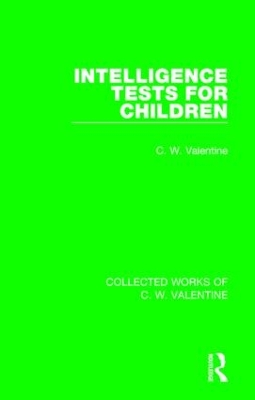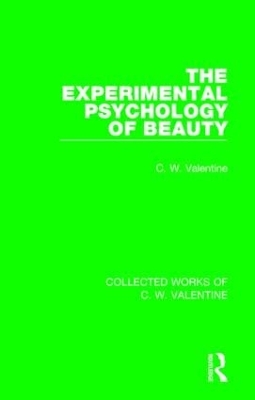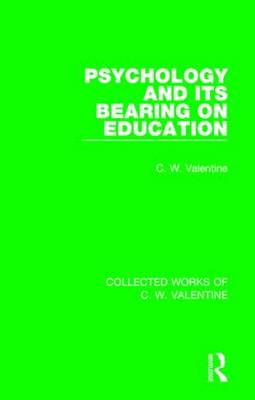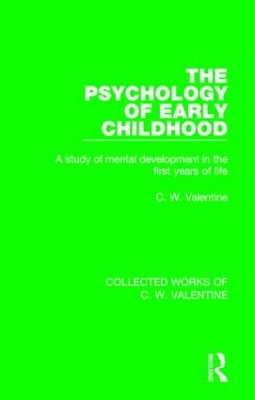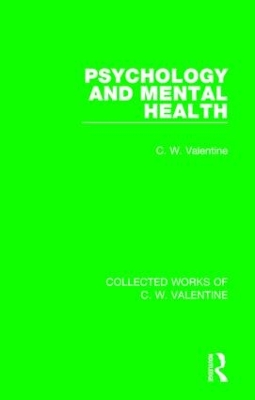Collected Works of C.W. Valentine
8 total works
Originally published in 1945, this title was intended mainly for use by teachers wishing to test children from ages 2-8 in order to establish their intelligence. Based on feedback to the author, this revised edition also includes tests for children up to the age of 15. The tests were used to give a teacher some idea of how much could be expected of each child, so that the class, when practicable, could be divided into groups of varying abilities, which could proceed at paces suited to their respective capacities. It was felt that if 'inborn intellectual deficiencies' could be identified at an early age the children could have 'special treatment', or in certain cases be placed in a 'special school', rather than be potentially written off as 'lazy'. Today this can be read and enjoyed in its historical context.
Charles W. Valentine (1879-1964) is an important figure in the history of educational psychology. Leaving school at 17 to become a teacher, he continued to study at the same time, gaining degrees from London, Cambridge and St. Andrews. He was professor of education at the University of Birmingham in 1919 until his retirement in 1946, then president of the British Psychological Society from 1947-1948. His research covered many areas including child development, imagery, mental testing, home and classroom discipline. Out of print for many years, the Collected Works of C.W. Valentine is an opportunity to revisit many of his finest works.
Originally published in 1962, the experimental study of aesthetics was a field particularly associated with the name of C.W. Valentine, who in this book provided a critical review of research carried out since the end of the nineteenth century principally by British and American psychologists. The investigations described, many of them conducted by the author, are concerned with individual responses to what is commonly regarded as beautiful in painting, music, and poetry, an important distinction being made between the perception of objects as 'beautiful' as opposed to 'pleasing'. The reactions of children and adults, and of people having different ethnic and social backgrounds, are explored in a variety of experiments dealing with specific elements, including colour, form, and balance in painting; musical intervals, discord, harmony, melody, and tempo; and rhythm, metre, imagery, and associations in classical and romantic poetry. Other experiments seek to disclose the temperamental and attitudinal factors underlying individual differences in the judgement and appreciation of specific works of art. Of particular interest are the studies of responses to modern paintings, poems and musical compositions.
The findings throw light on the development of discrimination and taste and suggest the possibility of some common factor in the appreciation of these three arts. It was felt that critics as well as psychologists and aestheticians would find much to encourage reflection and to stimulate further research.
By his wide influence as author and teacher C.W. Valentine had established himself as a leading authority in this country on child psychology applied to early training. Originally published in 1953, this was a book for parents who need help and advice in bringing up their children and who were puzzled by the obscure and often contradictory assertions of child psychologists.
This book deals with the earliest problems – feeding, weaning, sleep, etc.; it then goes on to early discipline, first school difficulties and adolescence. The great individual differences in children, frequently in the same family, are stressed, so that parents would not be so ready to imagine behaviour to be abnormal. It also sought to help parents understand themselves in their attitude towards their children.
As teachers, social and religious workers, children’s welfare officers and nurses, were increasingly brought into touch with parents to discuss with them the upbringing of their children, it was hoped that this book would be of use to those groups as well as to parents themselves.
Originally published in 1940, this book was addressed to students of the psychology of childhood and to parents and teachers who were trying to get from psychology some light on problems of discipline and of the difficult child. It includes critical discussions of some ideas which were gaining widespread attention at the time and which masqueraded as sound psychology, but which seem to be both untrue and harmful.
Topics dealt with include: fads and fallacies about discipline, repression and the inferiority complex, the supposed significance of sex in early childhood, early signs of abnormality, inborn individual differences, heredity and environment, are there "no problem children, only problem parents"?, is character determined by the early years?, the nursery school and the child guidance clinic, home discipline and the cooperation of parents, fallacies about corporal punishment.
Originally published in 1950, the author after many years' teaching of psychology, and previous school teaching experience, provided a book specially suitable for students in training colleges and university education departments, for teachers, youth leaders, and all concerned with the training of children and adolescents at the time. He aimed especially at clarity, the provision of concrete illustrations, and the stressing of material of general agreement among psychologists.
The topics include: The Development and Training of Personality and Character; The Basic Motives; Suggestion; Unconscious Influences; Sex Education; Learning and Remembering; Repression and Discipline; Play and Activity Methods; The Interests of Children; The Acquisition of Skill; Training in Reasoning; General Intelligence and Special Abilities, and their Testing; Estimating Personality and Character; Educational and Vocational Guidance; School Records; Stages of Development in Infancy, Middle Childhood and Adolescence; Backward, Problem and Delinquent Children.
The Appreciation of Beauty and Aesthetic Education: (1) Nature and Visual Art (2) Music (3) Poetry. Considerable space was given to these three in view of their usual neglect in textbooks of psychology at the time.
A brief appendix gives simple explanations of the most essential statistical methods applied to psychology and education.
The need of one book to cover the whole course in Psychology and its bearing on Education had long been felt, and it was hoped that this volume would fulfil this purpose.
Originally published in 1942, this title attempted to trace, from their very earliest appearances after birth, all aspects of mental development in childhood up to the age of about 4 or 5. It is based largely on the author's almost daily observations of his own five children, over a period of some twenty years, supplemented by numerous tests and experiments.
The first purpose of this book was to advance our knowledge of the psychology of childhood. The importance of such knowledge had become increasingly recognised. Even if not all is completely determined in the first 4-5 years, there was little doubt by this time that these first years are of profound significance for future development: and the better understanding and training of the young child may be at the root of many of our educational and social problems.
Originally published in 1948, this book deals, in a non-technical way, with such topics as Worry and Conflict; Repressions, Irritability and Complexes; Depression, Inferiority and Loneliness; Suggestion and Auto-Suggestion. Each topic is illustrated by reports of actual cases.
A series of broadcast talks on these subjects by the author (given in 1946) were so widely appreciated, and so many requests for publication were made, that the talks were expanded and revised so as to be more suitable for reading.
Discoveries of the wide prevalence of minor neuroses at the time had led to an increased interest in the subject and the demand for simple exposition. It was also thought that some popular illusions should be dispelled.
The talks were designed not only to explain some common mental disorders, but to help some of those numerous individuals who were struggling with difficult mental situations, or were often lonely and depressed.
